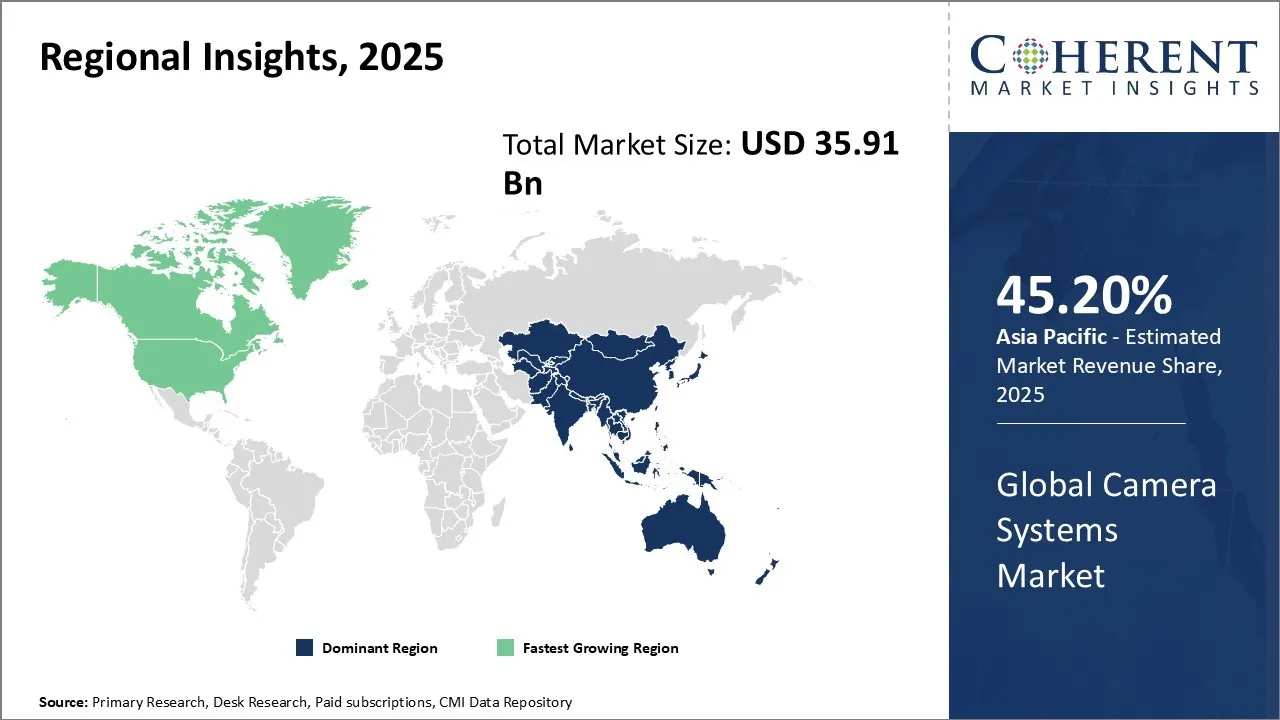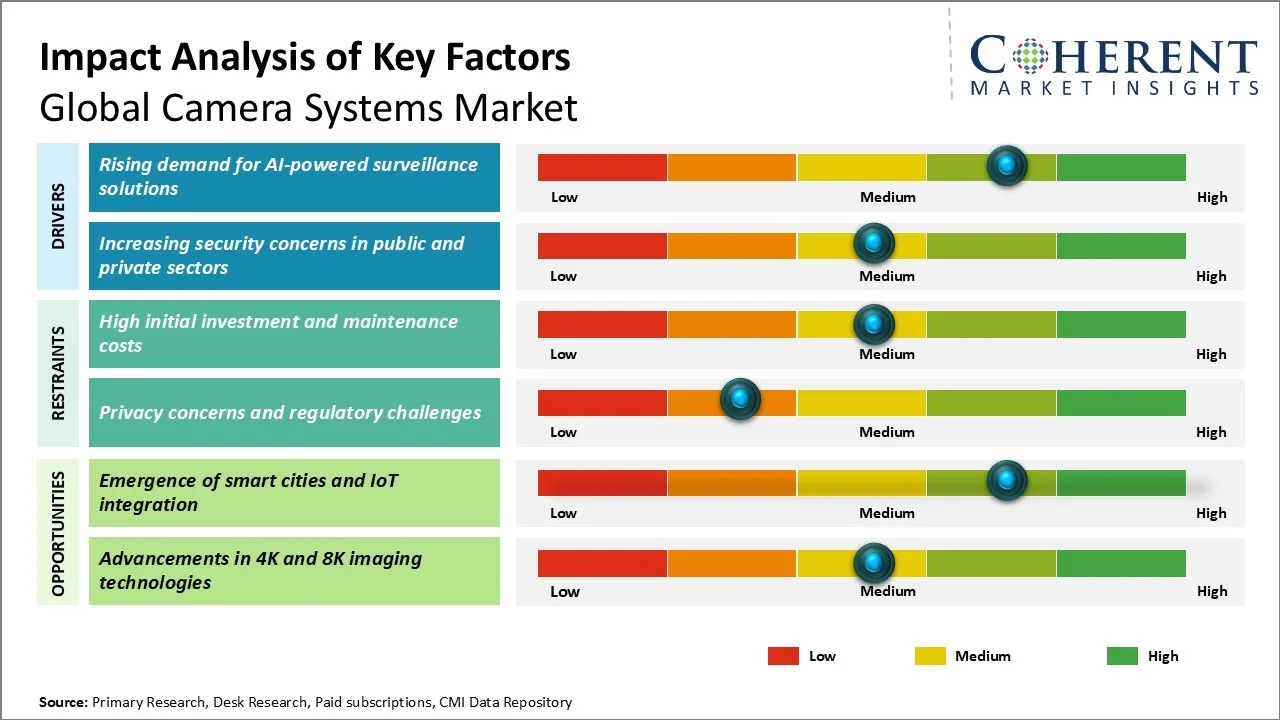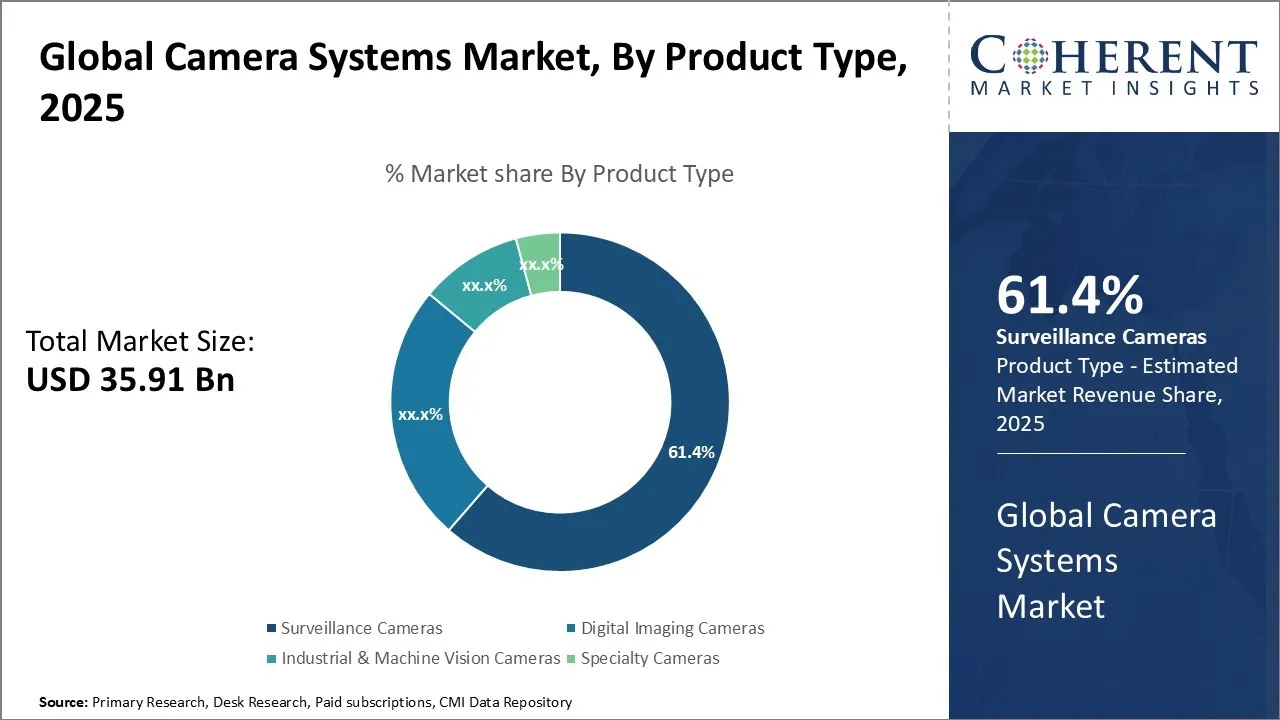Global Camera Systems Market Size and Forecast – 2025-2032
The Global Camera Systems Market is estimated to be valued at USD 35.91 Bn in 2025 and is expected to reach USD 58.04 Bn by 2032, exhibiting a compound annual growth rate (CAGR) of 7.1% from 2025 to 2032.
Key Takeaways of the Global Camera Systems Market:
- The surveillance cameras segment is expected to lead the market holding a share of 61.4% in 2025.
- The IP/Network cameras segment is projected to dominate with a share of 49.6% in 2025.
- Asia Pacific is estimated to lead the market with a share of 45.2% in 2025. North America, holding a share of 26.3% in 2025, is projected to be the fastest growing region.
Market Overview:
The significant growth of the camera systems market can be attributed to the increasing demand for advanced camera systems from different industries, including surveillance, automotive, healthcare, and entertainment, as well as the rapid advancements in camera technology, such as higher resolution, improved low-light performance, and enhanced connectivity features.
Current Events and their Impact
|
Current Events |
Description and its impact |
|
Geopolitical Trade Policy Shifts |
|
Uncover macros and micros vetted on 75+ parameters: Get instant access to report
Global Camera Systems Market Insights by Product Type - Surveillance Cameras Lead Due to Increasing Demand for Enhanced Security and Monitoring Solutions
Surveillance cameras have become an integral part of modern security infrastructure, holding a share of 61.4% in 2025, with their widespread adoption in both public and private sectors. Growing concerns over crime, terrorism, and vandalism have fueled the demand for advanced surveillance systems that can effectively monitor and record activities in real-time. Governments and law enforcement agencies are investing heavily in surveillance cameras to maintain public safety, prevent criminal activities, and gather evidence for investigations. In December 2024, Panasonic Life Solutions India introduced two advanced AI-powered surveillance solutions.
In addition to security applications, surveillance cameras are also being used for various other purposes, such as traffic monitoring, crowd management, and quality control in manufacturing facilities. The retail sector, in particular, has seen a significant uptake of surveillance cameras to prevent shoplifting, monitor customer behavior, and optimize store layouts.
Global Camera Systems Market Insights by Technology - IP/Network Cameras Lead Due to Their Superior Performance and Flexibility
IP/Network cameras have emerged as the dominant technology in the camera systems market, holding a share of 49.6% in 2025, owing to their numerous advantages over analog cameras. These cameras transmit digital video data over an IP network, allowing for easy integration with existing network infrastructure and enabling remote access to live feeds and recorded footage. Also, these cameras typically feature higher resolutions, better color reproduction, and improved low-light performance compared to analog cameras. Moreover, these cameras can be easily added to an existing network, and their configurations can be remotely managed and updated. This allows for the seamless expansion of surveillance systems as the needs of an organization grow. For instance, VIVOTEK launched MS9321-EVH-V2 Multiple Sensor Network Camera at ISC West 2024, held in April 2024 in Las Vegas.
Pricing Analysis of the Camera Systems Market
|
Category |
Sub-Type / Feature |
Application Segment |
Estimated Price Range (USD) |
Notes |
|
Consumer IP Cameras |
Basic HD (720p–1080p), Wi-Fi |
Home Security |
USD 30 – USD 120 |
Common brands: TP-Link, Wyze, Xiaomi. Limited AI, basic night vision. |
|
Smart AI-enabled Cameras (2K–4K) |
Home/Small Business |
USD 100 – USD 300 |
Brands like Arlo, Eufy; include object/person detection, cloud storage. |
|
|
Commercial Surveillance Cameras |
Dome/Bullet Cameras (HD, Night Vision, PoE) |
Retail, Offices, Public Venues |
USD 150 – USD 400 |
Hikvision, Dahua dominate this space. Bulk discounts often available. |
|
PTZ Cameras (Pan-Tilt-Zoom) with AI Analytics |
Urban Monitoring, Transport |
USD 400 – USD 1,200 |
Used in smart cities and traffic surveillance. Advanced zoom & tracking. |
|
|
Enterprise IP Cameras |
4K AI Surveillance, Facial Recognition |
Airports, Critical Infrastructure |
USD 800 – USD 2,500 |
Often integrated with VMS and cloud storage platforms. |
|
Industrial Vision Systems |
Machine Vision Cameras (Line/Area Scan) |
Manufacturing, Robotics |
USD 1,500 – USD 5,000 |
Basler, Cognex, FLIR—used for precision inspection. |
|
Thermal & Infrared Cameras |
Thermal Imaging with AI Capabilities |
Border Security, Oil & Gas |
USD 2,000 – USD 8,000+ |
FLIR, Axis; pricing varies by range, resolution, and ruggedization. |
|
Multi-Sensor & 360° Cameras |
Multi-lens AI Cameras (12MP–32MP) |
Urban Surveillance, Stadiums |
USD 600 – USD 3,500 |
Vivotek, Avigilon; high-resolution panoramic and analytics. |
|
Body-Worn Cameras |
Police-Grade, with Live Streaming |
Law Enforcement, Field Services |
USD 300 – USD 900 |
Axon, Motorola; often bundled with software subscriptions. |
Uncover macros and micros vetted on 75+ parameters: Get instant access to report
Regional Insights

To learn more about this report, Download Free Sample
Asia Pacific Camera Systems Market Analysis and Trends
Asia Pacific, holding a share of 45.2% in 2025, is expected to dominate the global camera systems market. The region boasts rapid urbanization, increasing disposable incomes, and growing awareness about security and surveillance in countries like China, India, and Japan. The region's burgeoning middle class has shown a keen interest in adopting camera systems for both personal and business purposes.
Moreover, the governments in these countries have been actively investing in smart city projects and infrastructure development, which has further boosted the demand for camera systems. In February 2024, Hikvision India partnered with local authorities in Ahmedabad, Gujarat, to deploy a large-scale AI-enabled surveillance network as part of the city’s Smart City initiative. The project involved the installation of over 4,500 IP-based smart cameras integrated with facial recognition and traffic violation detection software. The presence of major camera system manufacturers like Hikvision, Dahua Technology, and Canon in the region has also contributed to the market's growth.
North America Camera Systems Market Analysis and Trends
North America, holding a share of 26.3% in 2025, is projected to exhibit the fastest growth in the global camera systems market. This growth can be attributed to the robust market ecosystem, with a strong presence of key industry players and advanced technological infrastructure. The U.S., in particular, has been at the forefront of camera system innovations, with companies like GoPro, Axis Communications, and Pelco by Schneider Electric leading the way.
In January 2024, Motorola Solutions launched the Avigilon Unity video security suite, targeting enterprise and government sectors in North America. This platform leverages AI-powered cameras and cloud-based analytics to deliver unified video surveillance and access control. Additionally, the high disposable income of consumers in North America has fueled the demand for advanced camera systems for personal and professional use.
Global Camera Systems Market Outlook for Key Countries:
U.S. Camera Systems Market Analysis and Trends
The U.S. is home to several major players in the industry, such as Cisco Systems, Honeywell, and Motorola Solutions. These companies are driving the adoption of camera systems in different sectors, including law enforcement, retail, and transportation. The U.S. government's focus on homeland security and public safety is also adding to market growth, resulting in investments in surveillance and monitoring systems.
China Camera Systems Market Analysis and Trends
China camera systems market has witnessed remarkable growth in recent years, driven by the country's rapid economic development and increasing focus on public safety. The government's initiatives, such as the "Safe City" project and the "Skynet" surveillance system, have created a massive demand for camera systems. Chinese companies like Hikvision and Dahua Technology have emerged as global leaders in the industry, offering cost-effective and feature-rich camera solutions.
Japan Camera Systems Market Analysis and Trends
Japan continues to be a major player in the global camera systems market, with a strong focus on quality, reliability, and advanced technology. Japanese companies like Sony, Panasonic, and Fujitsu have been at the forefront of camera system innovations, offering high-end solutions for various applications. Additionally, Japan's stringent safety and security regulations have encouraged the adoption of camera systems in public spaces and transportation networks.
India Camera Systems Market Analysis and Trends
India camera systems market is experiencing significant growth, driven by the country's increasing focus on public safety, smart city initiatives, and infrastructure development. The government's "Safe City" project, which aims to enhance the safety and security of citizens in major cities, has created a substantial demand for camera systems. Indian companies like CP Plus and Matrix Comsec have emerged as key players in the market, offering affordable and feature-rich camera solutions.
Market Players, Key Development, and Competitive Intelligence

To learn more about this report, Download Free Sample
Key Developments:
- In December 2024, Panasonic launched two new innovative surveillance solutions at the IFSEC India 2024, South Asia’s largest security expo and conference held in New Delhi, India. The solutions included the AI-enabled High Zoom Bullet Camera and X-series Camera with AI based On-site Learning analytics.
- In December 2024, 3D PLUS expanded its space camera portfolio with the introduction of MCAM multi-camera system. This product, developed under the Mars Sample Return – Earth Return Orbiter (MSR-ERO) project, is now available as a standard offering.
- In October 2024, Planitar Inc., makers of iGUIDE, a proprietary camera and software platform for capturing and delivering 3D virtual tours and property data, introduced iGUIDE PLANIX R1, a fast, lightweight, and affordable lidar-equipped 360-degree camera system for creating accurate floor plans, 3D tours, ESX files, CAD drawings and 3D models.
- In March 2024, e-con Systems launched e-CAM56_CUOAGX, a 5MP high-resolution shutter camera featuring the Pregius S IMX568 sensor engineered to obtain sharp high-quality images of objects in motion at a high frame rate. This camera supports multi-camera synchronization, with up to four cameras, while retaining a frame rate of up to 280 fps.
Top Strategies Followed by Global Camera Systems Market Players
- Established players are investing heavily in research and development to create high-performance products.
- In March 2024, Axis Communications, a global leader in video surveillance, launched a new line of ARTPEC-8-powered cameras featuring edge-based deep learning analytics.
- Mid-level players are adopting strategies that prioritize cost-effectiveness and collaboration to deliver quality products at budget-friendly prices, targeting price-sensitive consumers.
- In January 2024, VIVOTEK partnered with Trend Micro to integrate cybersecurity solutions into its mid-range network cameras without significantly increasing cost.
- Small-scale players are targeting specific market segments with specialized features or innovative products to differentiate themselves from larger competitors.
- In late 2023, Reolink introduced the Reolink Duo 2, a dual-lens camera with a 180-degree panoramic view aimed at home users and small businesses. It gained attention for combining panoramic surveillance, smart alerts, and 4K video at a competitive USD 200 price point.
Market Report Scope
Camera Systems Market Report Coverage
| Report Coverage | Details | ||
|---|---|---|---|
| Base Year: | 2024 | Market Size in 2025: | USD 35.91 Bn |
| Historical Data for: | 2020 To 2024 | Forecast Period: | 2025 To 2032 |
| Forecast Period 2025 to 2032 CAGR: | 7.1% | 2032 Value Projection: | USD 58.04 Bn |
| Geographies covered: |
|
||
| Segments covered: |
|
||
| Companies covered: |
Axis Communications, Bosch Security Systems, Canon Inc., Dahua Technology, FLIR Systems, Fujifilm Holdings Corporation, Hanwha Vision, Hikvision Digital Technology, IDIS Co., Ltd., Nikon Corporation, Panasonic Corporation, Samsung Electronics Co., Ltd., Sony Corporation, Teledyne DALSA, and Vivotek Inc. |
||
| Growth Drivers: |
|
||
| Restraints & Challenges: |
|
||
Uncover macros and micros vetted on 75+ parameters: Get instant access to report
Market Dynamics

To learn more about this report, Download Free Sample
Global Camera Systems Market Driver - Rising Demand for AI-powered Surveillance Solutions
As organizations across various sectors seek to enhance security measures and optimize their monitoring capabilities, there is a growing interest in camera systems that incorporate artificial intelligence technologies. These AI-powered solutions offer advanced features such as facial recognition, object detection, and behavioral analysis, enabling more effective and efficient surveillance.
Moreover, AI-powered surveillance solutions can help reduce false alarms, improve response times, and provide valuable insights for investigations. In April 2024, Hanwha Vision launched a new line of AI-based surveillance cameras under its Wisenet X Core and Pro series, which feature advanced deep-learning-based object detection. These cameras can differentiate between vehicles, people, and irrelevant motion (like waving trees or small animals), thereby reducing false alarms and improving situational awareness.
Global Camera Systems Market Opportunity: Emergence of Smart Cities and IoT Integration
Camera systems equipped with intelligent video analytics, facial recognition, and real-time data processing capabilities are crucial components in enabling smart city applications such as traffic management, public safety, and environmental monitoring. The integration of camera systems with IoT devices and sensors allows for the collection and analysis of vast amounts of data, enabling city authorities to make data-driven decisions and optimize urban operations.
In 2024, for its Urban Mobility Project, Barcelona deployed a network of AI-enabled, IoT-integrated surveillance cameras in collaboration with Axis Communications and local authorities.
Furthermore, the rise of 5G networks and edge computing technologies is expected to enhance the capabilities of camera systems, allowing for faster data transmission, reduced latency, and improved real-time monitoring.
Analyst Opinion (Expert Opinion)
- While high-end surveillance and industrial cameras boast AI-driven features like object detection and behavioral analytics, there remains a significant gap in affordable AI-integrated solutions for small businesses and residential users. Vendors must focus on democratizing AI by embedding cost-effective intelligence into lower-tier devices to widen adoption.
- The lack of unified standards across camera brands and management systems creates compatibility challenges, especially for integrators handling multi-vendor ecosystems. There is an unmet need for standardized open-platform solutions or more robust cross-brand API frameworks to ease deployment and upgrades.
- Despite the network-centric nature of modern IP cameras, many vendors treat cybersecurity reactively. With increasing vulnerabilities in edge devices, the market lacks proactive security-first camera systems, especially for critical infrastructure. End-to-end encryption, secure boot, and zero-trust architectures should be a standard, not a premium feature.
Market Segmentation
- Product Type Insights (Revenue, USD Bn, 2020 - 2032)
-
- Surveillance Cameras
- Digital Imaging Cameras
- Industrial & Machine Vision Cameras
- Specialty Cameras
- Technology Insights (Revenue, USD Bn, 2020 - 2032)
-
- IP/Network Cameras
- Analog Cameras
- Thermal & Infrared Cameras
- AI-Integrated Smart Cameras
- Regional Insights (Revenue, USD Bn, 2020 - 2032)
-
- North America
- U.S.
- Canada
- Latin America
- Brazil
- Argentina
- Mexico
- Rest of Latin America
- Europe
- Germany
- U.K.
- Spain
- France
- Italy
- Russia
- Rest of Europe
- Asia Pacific
- China
- India
- Japan
- Australia
- South Korea
- ASEAN
- Rest of Asia Pacific
- Middle East
- GCC Countries
- Israel
- Rest of Middle East
- Africa
- South Africa
- North Africa
- Central Africa
- North America
- Key Players Insights
-
- Axis Communications
- Bosch Security Systems
- Canon Inc.
- Dahua Technology
- FLIR Systems
- Fujifilm Holdings Corporation
- Hanwha Vision
- Hikvision Digital Technology
- IDIS Co., Ltd.
- Nikon Corporation
- Panasonic Corporation
- Samsung Electronics Co., Ltd.
- Sony Corporation
- Teledyne DALSA
- Vivotek Inc.
Sources
Primary Research Interviews:
Stakeholders:
- Security Solutions Integrators and Consultants (e.g., Surveillance Project Leads, Technical Architects)
- Camera System Manufacturers and OEMs
- Smart City Infrastructure Developers
- Retail and Commercial Property Security Managers
- IT & Network Infrastructure Specialists
- Public Safety Department Heads and Law Enforcement Technicians
Databases:
- UN Office on Drugs and Crime (UNODC) – Security Data Hub
- U.S. Department of Homeland Security (DHS) Infrastructure Statistics
- Asia-Pacific Tech Security Archives
- Middle East Surveillance Deployment Report
- European Urban Safety Analytics Network (EUSAN)
Magazines:
- Security Solutions Monthly
- IP Camera World
- Digital Surveillance Review
- Intelligent Infrastructure Magazine
Journals:
- Journal of Smart Surveillance Systems
- Imaging Technology and Security Applications Journal
- Journal of AI and Vision-Based Systems
- Global Journal of Public Safety Technology
Newspapers:
- Security News International
- Tech & Privacy Today
- Global Infrastructure Daily
- The Global Observer (Technology & Safety Section)
Associations:
- International Association for Surveillance Technology (IAST)
- Global Network Camera Alliance (GNCA)
- Urban Security Technology Council (USTC)
- The IP Video Surveillance Association
- Association of Vision & Imaging Professionals (AVIP)
Public Domain Sources:
- U.S. Census Bureau
- EUROSTAT
- United Nations Economic Commission for Europe (UNECE)
- World Bank
- ResearchGate
Proprietary Elements:
- CMI Data Analytics Tool, Proprietary CMI Existing Repository of information for last 8 years
Share
Share
About Author
As an accomplished Senior Consultant with 7+ years of experience, Pooja Tayade has a proven track record in devising and implementing data and strategy consulting across various industries. She specializes in market research, competitive analysis, primary insights, and market estimation. She excels in strategic advisory, delivering data-driven insights to help clients navigate market complexities, optimize entry strategies, and achieve sustainable growth.
Missing comfort of reading report in your local language? Find your preferred language :
Transform your Strategy with Exclusive Trending Reports :
Frequently Asked Questions
EXISTING CLIENTELE
Joining thousands of companies around the world committed to making the Excellent Business Solutions.
View All Our Clients


